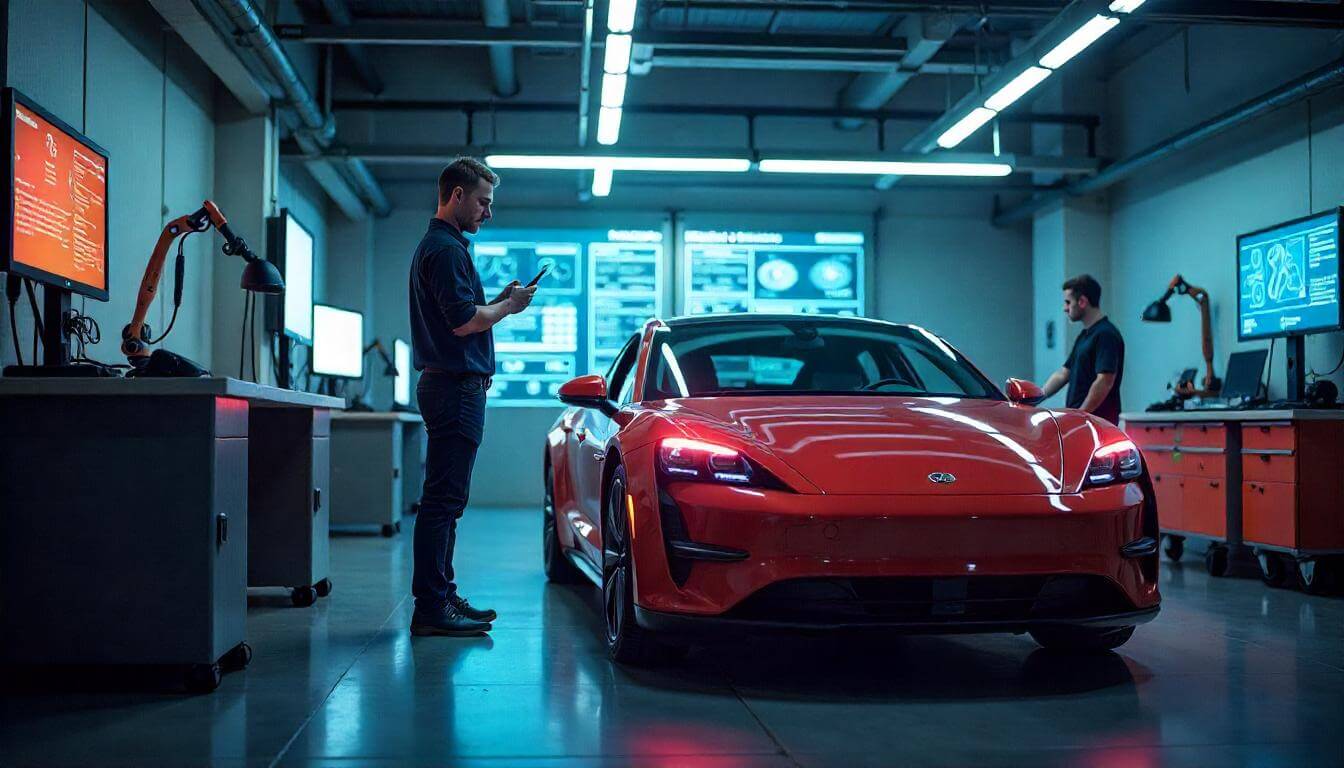Car Service 2025 is undergoing a transformation driven by technology, rising prices and a changing car fleet. In Russia, where the market is increasingly dependent on Chinese brands and electric cars are gradually gaining popularity, car services are adapting to the new realities. What innovations await car owners? How will digitalisation, parts shortages and regulatory changes affect the cost and quality of service? In this article, I will look at the key trends, challenges and forecasts for car service in 2025, based on current data and expert opinions.
Current situation in the car repair shop
To understand how car service will change 2025 changes in which are on the way, it is worth looking at the market at the beginning of the year. According to Avtostat, in 2024, the average cost of maintenance (TO) will increase by 15%, to 12,000 rubles, due to the rising cost of spare parts and oils [web:9]. Chinese brands such as Chery and Haval dominate new car sales (60% of the market), but their maintenance is complicated by a lack of specialists and rare parts [web:23]. Also, the departure of European brands has reduced the share of warranty service by 8%, redistributing customers to independent service stations [web:9]. As a result, the car service market is becoming more and more complex and competitive.
Structure of car services
The Russian service market is divided into official dealerships, network service stations (e.g. Fit Service), independent workshops and garage services. In 2024, dealerships will service 30% cars, network service stations will service 25% cars, and the rest will go to independent and garage workshops [web:3]. The shortage of staff - up to 20% vacancies in service stations remain open - forces services to raise prices for services [web:1]. However, competition is forcing the introduction of new technologies to retain customers. Thus, the market is preparing for changes.
Popular services
In 2024, drivers most often turned to replace oil, filters, spark plugs and windscreen wiper blades, according to data from the Avtorus holding company [web:2]. Demand for these procedures increased by 10% due to severe weather conditions and wear and tear on parts. The number of requests for Chinese car repairs has also increased - the share of such orders at Fit Service rose to 40% [web:9]. In addition, the popularity of electric vehicles such as BYD has increased demand for battery diagnostics [web:1]. As a result, services are adapting to new challenges.
Key trends in car service for 2025
Automotive Service 2025 changes in which are related to global and local factors, will be shaped by technology and market conditions. Here are the main directions.
Digitalisation of processes
Digitalisation is becoming a standard in car service stations. In 2024, 50% service stations offered online appointment and digital repair reports, and by 2025 the share will grow to 70%, according to Truth.ru forecasts [web:1]. For example, platforms like CarFix allow you to book services, get fixed prices and track repair status through an app [web:12]. In Moscow, services like Bolshegruz service SPb are testing chatbots for consultations [web:11]. Also, telematics - devices that track the condition of the car - reminds about the timing of maintenance, reducing the number of breakdowns by 10% [web:12]. In sum, digitalisation makes the service more convenient and transparent.
The growth of electric vehicle services
Electric vehicles (EVs) and hybrids account for 5% of the Russian car fleet in 2025, but their share may reach 20% by 2030, according to Avtostat [web:1]. EV maintenance requires new skills: battery diagnostics, electric motor repair and software updates. However, only 10% service stations in the regions are ready for such tasks due to a lack of equipment and specialists [web:1]. In large cities, such as Moscow, services like Fit Service already train masters to work with BYD and Zeekr [web:9]. In addition, the demand for charging stations is growing, with 15% more in 2025 [web:11]. Thus, EV service will become an important part of the market.
Increased cost of spare parts and services
The rise in parts prices - up to 20% in 2024 - will continue in 2025 due to currency fluctuations and the utilisation fee, which has increased by 70-85% [web:5][web:23]. For example, an oil change for a Chery Tiggo 7 now costs 10,000 rubles versus 8,000 a year ago [web:9]. Chinese parts are more affordable than European ones, but for rare models, such as Exeed VX, delivery time reaches 2 months [web:23]. The Car Service Union predicts that maintenance costs will rise by 10-12%, and complex repairs like turbine replacement will rise by 15% [web:23]. As a result, drivers will have to spend more.
Regulatory changes
From 1 September 2025, the labelling of motor oils through the Honest Mark system will prohibit the sale of oil from barrels, which will increase the costs of service stations by 5-7% [web:18]. This innovation, aimed at combating counterfeiting, will increase the price of oil changes for customers - from 6,000 to 6,500 rubles on average [web:18]. Also from March 1, 2025, the rules for car registration are tightened, including recycling fee checks, which will complicate "grey" imports of spare parts [web:13]. As a result, regulators will make the market more transparent, but more expensive.
Challenges for car service centres
Car Service 2025 changes in which brings and risks face obstacles affecting the quality and availability of services.
Shortage of qualified personnel
The shortage of mechanics and diagnosticians remains an acute problem, with 25% of service station vacancies unfilled in 2024, according to Pragmatica data [web:3]. Servicing complex systems, such as Geely's autopilots or BYD batteries, requires training that takes 6-12 months [web:1]. In the regions, the situation is worse: 80% foremen have no experience working with electric cars [web:1]. This forces service stations to raise salaries by 10%, shifting the costs to customers. As a result, the personnel crisis increases prices.
Shortage of spare parts for some brands
Although the supply of Chinese parts has been established, spare parts for European and Japanese cars imported through parallel imports remain a problem. For example, for BMW X5 the delivery time of filters reaches 3 months, and the cost has increased by 30% [web:23]. Counterfeiting is also on the rise - up to 15% of parts on the market are fake, according to the Auto Service Union [web:23]. For Chinese models, the deficit is less frequent, but rare units such as hybrid transmissions are expensive - repairs cost 150,000 rubles [web:9]. As a result, the availability of spare parts limits the service.
High competition
Independent service stations and garage workshops are taking customers away from dealers by offering services 20-30% cheaper [web:3]. In 2024, the share of unofficial services increased to 45% due to savings on analogue parts [web:2]. However, the quality of such services is lower - 10% of repairs require rework, according to Fit Service [web:6]. Dealers, on the other hand, rely on digitalisation and brand reputation, but are losing the budget segment. As a result, competition forces services to seek a balance between price and quality.
Forecast for 2025
How will car service 2025 change with technology and the economy? Here are the main scenarios.
Increasing the role of technology
By the end of 2025, 60% service stations will adopt AI for diagnostics, which will reduce inspection time by 20%, Forbes [web:12] predicts. For example, systems such as Bosch ADS already detect faults in 10 minutes [web:1]. Telematics will also become standard for new Chinese cars like the Haval F8, reminding you to change your oil or pads [web:11]. Online platforms like Auto.ru will expand features, allowing real-time comparison of repair prices [web:8]. As a result, technology will increase the speed and convenience of service.
Increase in prices for services
The average cost of maintenance in 2025 will be 13,500 rubles, and complex repairs will rise in price to 50,000 rubles for crossovers, according to Avtostat [web:9]. The main reasons are rising prices for parts and oils due to labelling and exchange rates [web:18]. Owners of Chinese autos such as the Chery Tiggo 8 will face lower cost increases (5-7%) than BMW or Toyota owners (15%) [web:23]. In addition, hull insurance can cover some of the repair costs, reducing the burden on the budget [web:14]. Thus, prices will rise, but unevenly.
Adaptation to Chinese brands
With the growing share of Chinese cars (up to 65% of the market), service stations will increase the stock of their parts and train craftsmen. Haval and Geely are already among the top 5 brands in terms of service orders in 2024 [web:9]. Chery dealers plan to open 50 new centres by the end of 2025, simplifying access to servicing [web:16]. However, for rare models such as the Jaecoo J8, parts shortages will persist [web:23]. As a result, service for "Chinese" will become more accessible than for "Europeans".
Recommendations for drivers
To adapt to changes in car service, follow these tips.
Use digital services
Book a service via apps such as CarFix or Auto.ru to save up to 10% due to transparent prices [web:12]. Check reviews of service stations on Drom or Yandex.Maps to avoid poor quality repairs [web:15]. Also connect telematics if your car supports it - this will reduce the risk of breakdowns by 15% [web:12]. Bottom line, digital tools will simplify maintenance.
Choose a trusted workshop
Prefer dealers or network workshops such as Fit Service for complex repairs, especially for Chinese cars or electric vehicles [web:3]. For example, Haval dealers offer a repair warranty of up to 6 months [web:9]. For simple procedures like oil changes, independent service stations are fine, but check oil certificates because of the labelling [web:18]. In the end, the reputation of the service reduces the risks.
Plan your budget
Take into account rising prices for maintenance and spare parts - save 15,000 roubles a year for maintenance for budget cars and up to 30,000 for premium cars [web:23]. Compare prices for spare parts through marketplaces such as Ozon, avoiding counterfeit [web:23]. Also take out hull insurance with repair coverage to save up to 50% on major breakdowns [web:14]. Bottom line, planning will protect against unexpected spending.
Outlook to 2030
By 2030, car service 2025 changes are just the beginning and will become fully digital. Online diagnostics and AI will reduce repair times by 30% and 80% service stations will service electric vehicles [web:1]. Chinese brands like BYD will take 70% of the market, making it easier to access parts, but European cars will become niche, with expensive repairs [web:16]. New regulations like filter and plug labelling will increase transparency, but increase prices 10% [web:18]. In addition, the development of 5G will accelerate the adoption of telematics, making TOs predictable [web:11]. Thus, the market is in for a technological leap, but with rising costs.
Bottom line: car service 2025 changes and challenges
Car service 2025 changes are inevitable and will become more technologically advanced and expensive. Digitalisation will make recording and diagnostics easier, and the rise of electric vehicles will require new skills from craftsmen. However, rising parts costs, staff shortages and regulatory innovations such as oil labelling will increase drivers' costs by 10-15%. Choose trusted service stations, utilise digital platforms and plan your budget to adapt to change. In the end, the car service will be more convenient but require more attention and money from car owners.

 How car service and maintenance will change in 2025">
How car service and maintenance will change in 2025">
